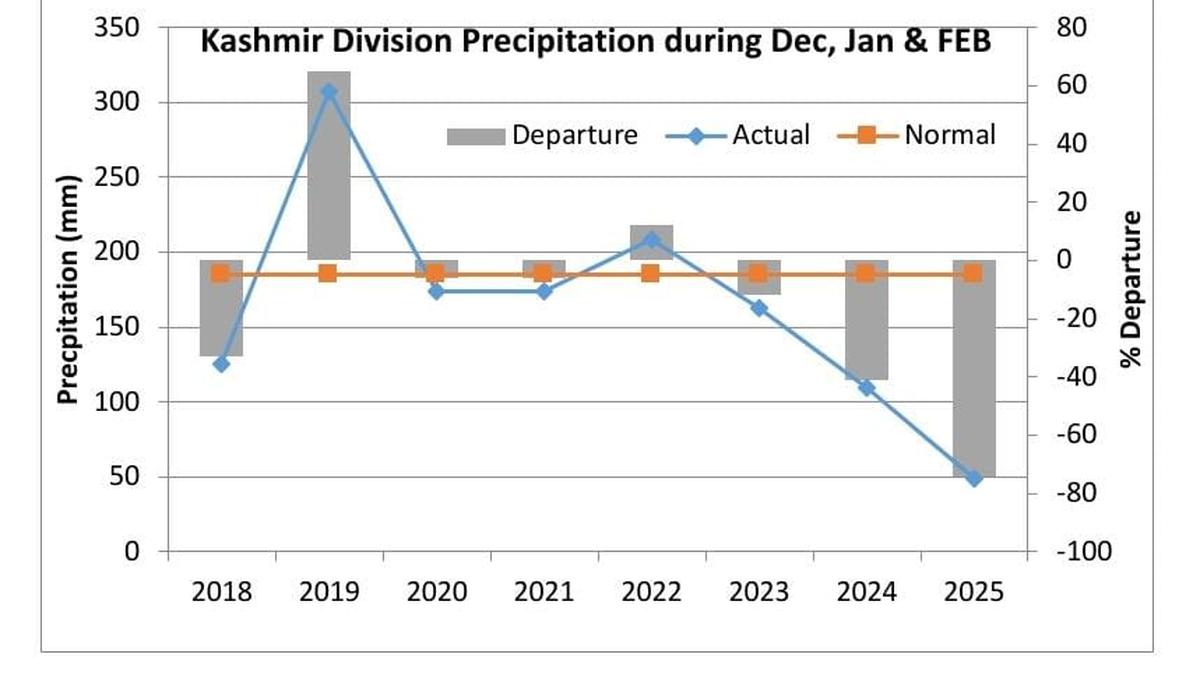
Dried up springs, receding rivers blow bugle of looming drought in Kashmir
The Hindu
Kashmir faces water crisis due to depleting rivers and canals, prompting officials to urge conservation and alternative crops.
Once water-abundant region of Kashmir is grappling with fast depleting waters in rivers, canals and streams this year. Scarce snowfall and rising temperatures are posing a drought threat to the region, which is dependent on water-intensive crops like rice and water-fed apple orchards.
This week, a grim picture of changing weather patterns was reported by netizens across the Kashmir valley. Dozens of videos of dried-up springs and receding streams were posted online by villagers from south Kashmir’s Anantnag, Kulgam, and Pulwama districts. It also included a canal fed by a revered spring at the famous Mughal garden of Achabal in Anantnag.
“I met the J&K Chief Secretary to share the concern over the drying up of the Achabal stream. The crisis has left 16 villages without water and threatens the essence of the iconic Mughal Garden. It’s deeply concerning. It sustains livelihoods, the famed Mughal Garden, and entire communities,” Peer Mansoor, former Minister from south Kashmir, said.
Experts blame the receding water levels to shortening of winter period and rising temperature in Kashmir. Srinagar on Wednesday (February 19, 2025) recorded a maximum temperature of 17.4°C, which is seven degrees above the normal temperature.
“Kashmir saw a sudden rise in temperature from the middle of January this year. The precipitation form had changed, especially during the late autumn and early spring, which usually were observed in the form of snow in the 1980s and mid-90s. Now, we are witnessing it in the form of rain. The winter period is shortened and confined to December and January, which otherwise in the past extend from October to March,” Dr. Mukhtar Ahmad, Director, Meteorological Department (MeT), Srinagar, told The Hindu.
According to MeT data, Kashmir saw a 79% rainfall deficit, with only 29.8mm of precipitation, from January 1 to February 19. This year, the month of February saw precipitation shortfall ranging between 70% and 80% in all districts. It resulted in the Jhelum river recording lowest water levels at multiple points. Officials said the water level at Sangam point was at -0.75ft, 3.73ft at Ram Munshi Bagh and 1.08ft at Asham. The average depth of the Jhelum river is between 2.4ft to 19.9ft in the Valley.
“The earth’s average temperature has increased by almost 1.5°C in the past five decades. The Himalayan range is the first indicator, as it witnesses rapid melting of glaciers, changes in precipitation patterns and shifting agriculture in higher altitudes,” Mr. Mukhtar said.













